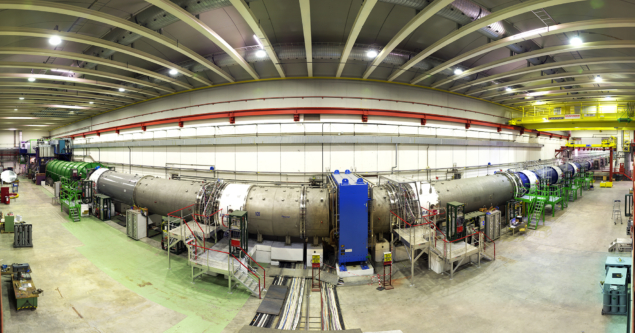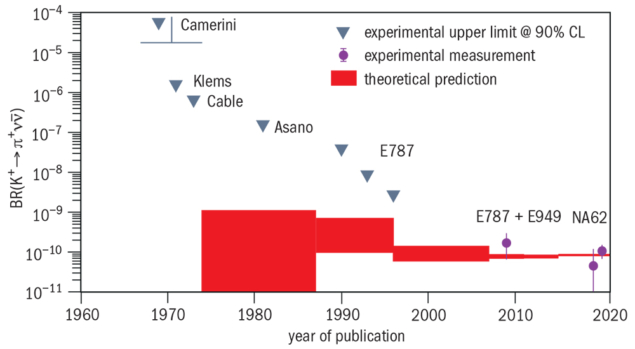
CERN’s NA62 collaboration has presented its latest progress in the search for K+→π+νν̄ – a “golden decay” with exceptional sensitivity to physics beyond the Standard Model. The new analysis, which includes the full dataset collected until 2018, provides the strongest evidence yet for the existence of this ultra-rare process, at 3.5σ significance. Presenting the result today during the penultimate plenary session of the 40th International Conference on High-Energy Physics, which is being virtually hosted from Prague, lead-analyst Giuseppe Ruggiero of Lancaster University described the result as a great achievement. “After several years of a very challenging analysis, battling ten orders of magnitude of background over the signal, we are proud to have achieved the first statistically significant evidence for a process which has great sensitivity to new physics,” he says.
An important virtue of K+→π+νν̄ is its clean theoretical character
Andrzej Buras
A flavour-changing, neutral-current process, K+→π+νν̄ is highly suppressed in the Standard Model, with contributions from Z-penguin and box diagrams with W, top quark and charm exchanges. The measured branching fraction of 110+40-35 per trillion K+→π+νν̄ decays is in agreement with the Standard Model prediction of 84 ± 10 per trillion (JHEP 11 033). “A particular and very important virtue of K+→π+νν̄ is its clean theoretical character, which can only be matched among meson decays by KL→π0νν̄, and possibly Bs,d→μ+μ–,” says Andrzej Buras of the Institute for Advanced Study in Garching, Germany. “This is related to the fact that the low-energy hadronic matrix elements are just those of the quark currents between the hadronic states, which can be extracted from the leading semileptonic decay K+→π0e+ν,” he explains, noting that higher-order QCD and electroweak corrections are already well known, and lattice QCD calculations should soon tackle the small, “long-distance” contributions to the amplitude.

NA62 observes the 6% of positively charged kaons that are produced when 450 GeV protons from the Super Proton Synchrotron strike a beryllium target. The analysis is challenging because of the tiny branching fraction and the presence of a neutrino pair in the final state. Pioneering the technique of observing kaon decays in flight, the collaboration measures the kinematics of both the initial kaon and the final-state pion to isolate the kinematic signature of K+→π+νν̄, before then suppressing other decay modes by a further eight orders of magnitude using particle-identification techniques.
The collaboration’s new result adds a further 17 events to its previous analysis (arXiv:2007.08218, submitted to JHEP), wherein three events observed in 2016 and 2017 yielded an estimated branching fraction of 47 +72-47 decays per trillion. The previous best measurement was by Brookhaven National Laboratory’s E787 and E949 experiments in the 2000s, which together inferred a branching fraction of 173 +115-105 per trillion (Phys. Rev. Lett. 101 191802).
Meanwhile in Japan
The NA62 result is expected soon to be complemented by a measurement of the related CP-violating KL→π0νν̄ decay by the KOTO collaboration at the J-PARC research facility in Tokai, Japan. This even rarer process has a predicted Standard Model branching fraction of just 34 ± 6 per trillion. KOTO’s 2015 data yielded no event candidates and a 90% confidence upper limit on the branching fraction of 3.0 per billion (Phys. Rev. Lett. 122 021802). The collaboration is now finalising its results from the 2016–2018 run, and plans to improve its sensitivity to less than 0.1 per billion by increasing the beam intensity and upgrading the KOTO detectors.
As experimental uncertainties are expected to approach the theoretical precision in coming years, explains Buras, K+→π+νν̄ and KL→π0νν̄ decays can probe scales as high as a few hundred TeV – beyond the reach of most B-meson decays. “K+→π+νν̄ is most sensitive to hypothetical Z′ gauge bosons, vector-like quark models, supersymmetry and some leptoquark models,” he says. “LHCb studies of KS→ μ+μ– and Belle II studies of B→ K(K*)νν̄ will also have a part to play, allowing a global analysis to test not only the concept of minimal flavour violation, but also probe new CP-violating phases and right-handed currents.”
Theorists expect to reach an accuracy of 5% on the predicted K+→π+νν̄ branching ratio towards the end of the decade. In the same period, the NA62 team is seeking to hone its resolution from the current 30% down to 10%. The collaboration will resume data taking in 2021, following upgrades to both beam and detector taking place during the ongoing second long shutdown of CERN’s accelerator complex.
Sensitivity to decay rates below the 10–11 level is now in sight
Cristina Lazzeroni
“The horizon of a new-physics programme with a sensitivity to decay rates well below the 10–11 level is now in sight,” says NA62 spokesperson Cristina Lazzeroni of the University of Birmingham, UK. “The instruments and techniques developed for the NA62 experiment will lead to the next generation of rare-kaon-decay experiments. For the longer term future, a high-intensity kaon-beam programme is starting to take shape at CERN, with prospects to measure the K+→π+νν̄ decay to a few per cent, address the analogous decay of the neutral kaon, and reach extreme sensitivities to a large variety of rare kaon decays that are complementary to investigations in the beauty-quark sector.”
Further reading
A Buras et al. 2014 JHEP 11 121








